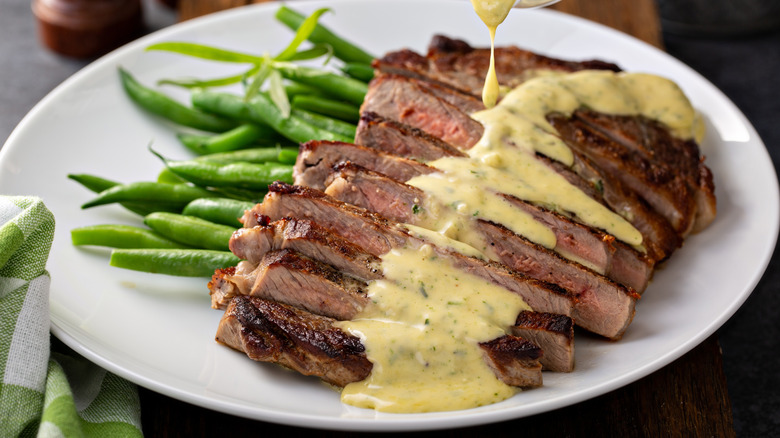The Biggest Mistake People Make When Cooking Wagyu, And How To Fix It
Fatty, savory, and tender, Wagyu beef is known for having abundant marbling and a supremely buttery taste and texture. These desirable qualities are specific to the Wagyu breed and the laborious way that the cows are raised. As such, cuts come with a famously high price tag (around $200 per pound or more), so if you are splurging, you want to make sure you treat it right. Unfortunately, there tends to be a bit of a learning curve, according to Pierre Albaladejo, Executive Chef at the Park Hyatt Aviara.
Speaking to Food Republic, Albaladejo said, "I've noticed that the biggest challenge when cooking Wagyu for the first time is the tendency to overcook it." This happens because Wagyu actually behaves a little bit differently than less rich varieties of beef. "Due to its high intramuscular fat content, Wagyu cooks faster than other meats," the chef explained.
The good news is that Wagyu is actually pretty easy to prepare, as long as you keep a close eye on it. Albaladejo advises to season it simply with salt and pepper "to let the amazing natural flavor of the Wagyu shine through." Get the pan ripping hot, hit it with some oil, and lay that steak down. For a rare doneness, pull it off the heat when it hits between 120 and 125 degrees Fahrenheit, which should take about three minutes per side, depending on the thickness of the beef. Then, rest it before cutting into very thin slices.
How to save overcooked Wagyu
Wagyu is most often served barely cooked, so that you can fully appreciate the silky texture and melt-in-your-mouth quality, but if you do happen to take it too far, all hope is not lost. That signature intense marbling and fatty richness ensures that Wagyu does not dry out easily. Though it will not be quite as decadent once you go past medium-rare, it will still be a very tasty steak.
To add back some moisture to the dish, you can use sauces to boost your steak meal. Pesto, chimichurri, and hollandaise or bearnaise sauce are all great choices. You can also use the rendered Wagyu fat and browned bits left behind in the pan to make a quick sauce. Deglaze the pan with a glug of white wine (or a white wine substitute), a little bit of stock or broth, a knob of cold butter, and a splash of heavy cream, and scrape up all the caramelized bits on the bottom of the pan as you stir to make it all come together.
Unfortunately, if your steak is seriously overdone, you may be better off repurposing it into another dish entirely. Finely chop the meat or break it down in the food processor, and then use it as part of a filling. Combine the meat with ricotta for a stuffed pasta or chopped cabbage and scallions for steamed dumplings. The deeply sweet and savory notes of the Wagyu will still be delicious, and the moisture of the other ingredients will balance out the drier texture of the overcooked meat.


